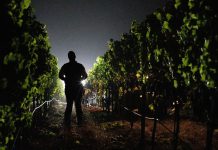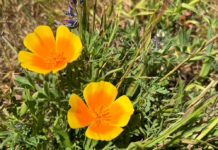Many lessons were learned from the wildfires of 2017. The most important of which is that any fire, with enough fuel and driven by wind can burn through almost anything. It is never possible to protect your property 100 percent, but there are things you can do with your landscaping to provide your family a fighting chance.
The best defense begins with defensible space. Landscaping within the first 30 feet of your home is critical. Planting low growing vegetation (waist high or lower), keeping trees pruned, and using automatic irrigation systems can do a lot to protect your home from wildfires.
Get in the zone
Zone 1 is what firefighting professionals call the first 30 feet from your home. This is the most critical area around your home and your last line of defense. Incorporating hardscape features into your landscaping plan like patios, meandering stone paths and low masonry walls can be used to form fuel breaks near your home. Plants are welcome here but need to be widely spaced in beds or containers and regularly irrigated. Water-efficient automatic drip irrigation systems can protect your home by keeping your landscaping green in the dry season.
Maintenance within Zone 1 is key. Keeping the fuel load low is the goal and you can do it yourself for free. Rake leaves during the summer and fall and put them in your green trash can. Avoid using chipped mulch in this zone as it can harbor embers and ignite unexpectedly even after a wildfire has passed by. If you have trees in this zone, always prune the low branches to maintain a gap of several feet between the ground vegetation and the lowest branches. Tree branches that overhang the roof of your home should always be pruned back. Don’t forget to remove the leaves from your roof and gutters in the summer and fall. Dried leaves are often the first thing to catch fire.
Properties in more urban neighborhoods can benefit from fire-resistant fences. Using thicker lumber (1.5 inches or more) or incorporating stone, masonry or metal into your fence design can be both an architectural statement and a shield against a fire. Design fire-resistant fences with minimal gaps. Gaps can provide a place for airborne embers to get trapped and smolder.
Regardless of the kind of fence you have, avoid stacking flammable material like firewood or lumber against it. A good rule of thumb is to never store flammable material like firewood and lumber anywhere in Zone 1. If you like desert flora, consider planting a cactus garden. Succulents are naturally full of water, require little maintenance and naturally resist catching fire.
Beyond Zone 1 is Zone 2, which extends another 70 feet from your home (for a total of 100 feet of defensible space). This is where careful pruning, wide plant spacing and mowing dry grass serve to reduce the intensity of the flames before they get to your home. Planting fire-resistant plants like California Fuchsia, sage, and California Redbud not only resist catching fire but are also drought tolerant so less water is needed to keep them green. A useful list of fire-resistant plants is available online from Fire Safe Marin at www.firesafemarin.org/plants/fire-resistant. Maintenance is key in Zone 2 too, if you cannot easily walk through this zone, then it is overgrown and needs to be pruned and/or mowed.
In all zones, avoid planting fire adapted plants. These are plants that have adapted themselves to burn periodically and actually encourage wildfires. Plants that drop lots of leaves have flakey bark or resinous stems are considered fire adapted. Eucalyptus trees, coyote bush (baccharis) and manzanita trees (manzanita shrubs can be OK if kept low) are examples of the plants you want to keep far from your home.
Not everyone can do everything. Just remember that if all you do is prune your trees, clean your gutters and rake your leaves you have already come a long way to having a defensible space.
The wildlands
Those who live next to open undeveloped land get to enjoy amazing views and a closeness to nature. This wildland-urban interface (WUI) also carries extra responsibility for fire protection. Wildland has few roads, is difficult to access and is rarely managed. Wildland has more vegetation than urban land and in the summer months, it can easily burn.
Many plants in our area rely on fire to reproduce and have adapted themselves to occasional wildfires. As our homes and neighborhoods have crept into these natural areas we have exposed ourselves to an environment that is meant to burn. If your home is along the WUI then careful landscape management is critical. Heavy brush, closely growing trees, and low branches can easily catch fire and burn intensely.
Even the 100-foot defensible space required by state law might not be enough. If your home borders wildland it is critical that you maintain the land around your home to be fire safe. Prune tree branches that are low to the ground, keep shrubs widely spaced and low (waist high or lower) and mow, mow, mow tall grass as soon as it turns brown.
Flirt with firefighters
Firefighters are attracted to defensible space and if you attract enough of them, they might bring their fire truck. When firefighters respond to wildland fires they need defensible areas to set up and fight the fire. If your home has a defensible area and access to water (nearby fire hydrant or a pool) firefighters can use your home as a staging area.
For those who live on the WUI, this is the best defense against wildfire for which you can hope. If you have a pool, consider installing a portable pump that firefighters can use. If you have space, include wide driveways and large turnaround spaces in your landscaping design. Many local fire departments offer free fire safety evaluations and will provide guidance on how to make your property firefighter friendly and wildfire-resistant.
This article was authored by Eric Janzen of the City of Cloverdale, on behalf of RRWA (www.rrwatershed.org), an association of local public agencies in the Russian River Watershed that have come together to coordinate regional programs for clean water, habitat restoration and watershed enhancement.









